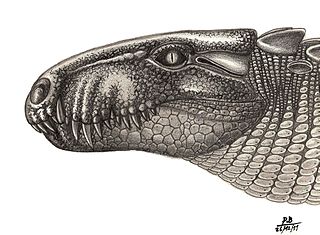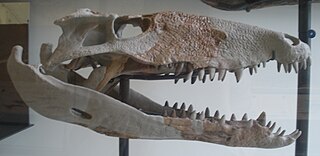
Doratodon is an extinct genus of Late Cretaceous crocodylomorph that may have been a member of the Sebecosuchia. Doratodon was a relatively small animal with ziphodont teeth, meaning the teeth had flattened sides and serrated edges. Two species of Doratodon are known to science: D. carcharidens from Austria and Hungary, the type species; and D. ibericus from Spain. Teeth similar to those of Doratodon are also known from Italy and Romania, though they cannot be confidently assigned to this genus.

Haopterus is a genus of pterodactyloid pterosaur from the Barremian-Aptian-age Lower Cretaceous Yixian Formation of Liaoning, China. Its fossil remains dated back 124.6 million years ago.

Notosuchia is a suborder of primarily Gondwanan mesoeucrocodylian crocodylomorphs that lived during the Jurassic and Cretaceous. Some phylogenies recover Sebecosuchia as a clade within Notosuchia, others as a sister group ; if Sebecosuchia is included within Notosuchia its existence is pushed into the Middle Miocene, about 11 million years ago. Fossils have been found from South America, Africa, Asia, and Europe. Notosuchia was a clade of terrestrial crocodilians that evolved a range of feeding behaviours, including herbivory (Chimaerasuchus), omnivory (Simosuchus), and terrestrial hypercarnivory (Baurusuchus). It included many members with highly derived traits unusual for crocodylomorphs, including mammal-like teeth, flexible bands of shield-like body armor similar to those of armadillos (Armadillosuchus), and possibly fleshy cheeks and pig-like snouts (Notosuchus). The suborder was first named in 1971 by Zulma Gasparini and has since undergone many phylogenetic revisions.

Baurusuchidae is a Gondwanan family of mesoeucrocodylians that lived during the Late Cretaceous. It is a group of terrestrial hypercarnivorous crocodilians from South America and possibly Pakistan. Baurusuchidae has been, in accordance with the PhyloCode, officially defined as the least inclusive clade containing Cynodontosuchus rothi, Pissarrachampsa sera, and Baurusuchus pachecoi. Baurusuchids have been placed in the suborder Baurusuchia, and two subfamilies have been proposed: Baurusuchinae and Pissarrachampsinae.

Langstonia is an extinct genus of notosuchian crocodylomorph of the family Sebecidae. It lived in the middle Miocene, in the "Monkey Beds" of the Colombian Villavieja Formation. Langstonia was named in 2007 by Alfredo Paolillo and Omar Linares for fossils originally described by Langston in 1965 as Sebecus huilensis. Thus, the type species is L. huilensis.

Bergisuchus is an extinct genus of small sebecosuchian mesoeucrocodylian known primarily from the Eocene Messel Pit in Germany. Few fossils of Bergisuchus have been discovered, only a single incomplete snout, a few partial lower jaws and some teeth. Despite being fragmentary, the jaw bones are enough to indicate that Bergisuchus had a short, deep, narrow snout and serrated teeth, quite unlike the broad flat snouts of modern crocodylians.

Bretesuchus is an extinct genus of sebecosuchian mesoeucrocodylian within the family Sebecidae known from northwestern Argentina. It was a large apex predator.
Ilchunaia is an extinct genus of sebecid mesoeucrocodylian. Fossils have been found from the Divisadero Largo Formation of Argentina dating back to the Late Eocene, and a locality in Mendoza, Argentina dating back to the Oligocene. Little material is known from the genus, with only the anterior portion of the skull being present to study.
Mahajangasuchidae is an extinct family of notosuchian crocodyliforms. It currently contains two genera, Mahajangasuchus and Kaprosuchus, both of which lived during the Late Cretaceous in Gondwana. It is defined as the most inclusive clade containing Mahajangasuchus insignis but not Notosuchus terrestris, Simosuchus clarki, Araripesuchus gomesii, Baurusuchus pachecoi, Peirosaurus torminni, Goniopholis crassidens, Pholidosaurus schaumbergensis, or Crocodylus niloticus. Phylogenetically, Mahajangasuchidae is placed just outside pholidosaurids and more derived neosuchians.

Sebecus is an extinct genus of sebecid crocodylomorph from Eocene of South America. Like other sebecosuchians, it was entirely terrestrial and carnivorous. The genus is currently represented by two species, the type S. icaeorhinus and S. ayrampu. Several other species have been referred to Sebecus, but were later reclassified as their own genera.

Sebecidae is an extinct family of prehistoric terrestrial sebecosuchian crocodylomorphs, known from the Late Cretaceous and Cenozoic of Europe and South America. They were the latest surviving group of non-crocodilian crocodylomorphs.
Sebecosuchia is an extinct group of mesoeucrocodylian crocodyliforms that includes the families Sebecidae and Baurusuchidae. The group was long thought to have first appeared in the Late Cretaceous with the baurusuchids and become extinct in the Miocene with the last sebecids, but Razanandrongobe pushes the origin of Sebecosuchia to the Middle Jurassic. Fossils have been found primarily from South America but have also been found in Europe, North Africa, Madagascar, and the Indian subcontinent.

Stratiotosuchus is an extinct genus of baurusuchid mesoeucrocodylian from the Adamantina Formation in Brazil. It lived during the Late Cretaceous. The first fossils were found in the 1980s, and the type species Stratiotosuchus maxhechti was named in 2001. A hyperpredator, it and other baurusuchids may have filled niches occupied elsewhere by theropod dinosaurs.

Pissarrachampsa is an extinct genus of baurusuchid mesoeucrocodylian from the Late Cretaceous of Brazil. It is based on a nearly complete skull and a referred partial skull and lower jaw from the ?Campanian - ?Maastrichtian-age Vale do Rio do Peixe Formation of the Bauru Group, found in the vicinity of Gurinhatã, Brazil.

Leyesaurus is an extinct genus of massospondylid sauropodomorph dinosaur known from the San Juan Province, northwestern Argentina.
Lorosuchus is an extinct genus of sebecid mesoeucrocodylian known from the Río Loro Formation in Tucumán Province of northwestern Argentina.

Europejara is a genus of tapejarid pterosaur from the Early Cretaceous period of Spain. The type and only species known is Europejara olcadesorum.

Sahitisuchus is an extinct genus of sebecid mesoeucrocodylian known from Rio de Janeiro State of southeastern Brazil. It contains a single species, Sahitisuchus fluminensis. It is a terrestrial sebecid, however also adopted to a semi-aquatic lifestyle to some degree, most probably coexisting with the semi-aquatic alligatorid Eocaiman itaboraiensis.
Titanochampsa is a genus of large mesoeucrocodylian from the Maastrichtian Marilia Formation of Brazil. Although only known from a single skull roof, the material shows that Titanochampsa was not a member of Notosuchia, which were previously believed to have been the only crocodyliforms present in the strata of the Bauru Group. Body size estimates vary greatly and range between 2.98–5.88 m due to the incomplete nature of the holotype fossil. The overall anatomy of the skull roof, alongside its size and possible affinities with Neosuchians, may suggest that it was a semi-aquatic ambush hunter similar to modern crocodilians.

Dentaneosuchus is a genus of large bodied sebecid crocodylomorph from the Middle Eocene of Issel and Réalmont (France). Originally described as Atacisaurus crassiproratus, the discovery of additional remains led to it being placed in a separate genus in 2023. It was tentatively recovered as the basalmost member of the family Sebecidae. Because of this Dentaneosuchus could play an important part in deciphering the origins and dispersal of European sebecids, as their presence on the continent, far away from their primary range in South America, is still not entirely resolved. It reached a similar size to the enormous Barinasuchus, making it not only one of the biggest sebecids but also the biggest terrestrial carnivore of Cenozoic Europe. Dentaneosuchus would have been an apex predator of its environment, capable of taking large prey such as Lophiodon. However, for as of yet unknown reasons crocodylomorphs would lose their spot as top predator in this part of the world by the end of the Eocene, with Dentaneosuchus representing one of the last members of its group in Europe.


















